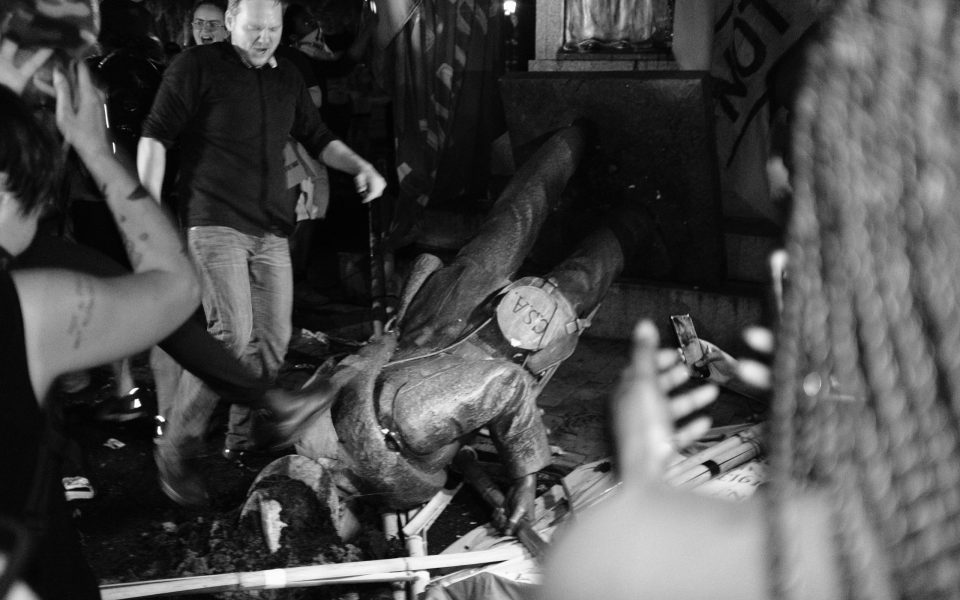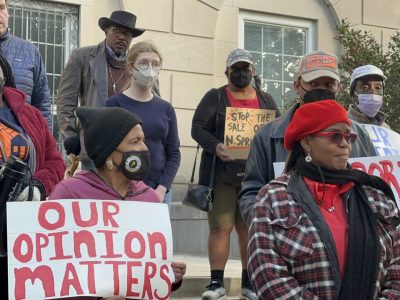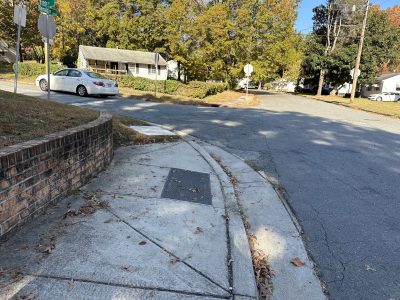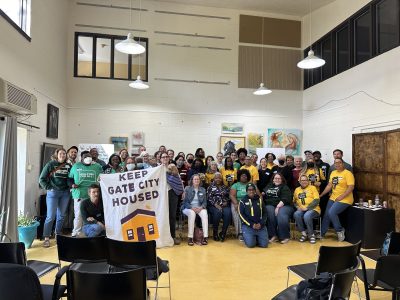“Tear it down, tear it down,” they chanted.
Then the metal husk of “Silent Sam” — a symbol of white supremacy to some and a monument to Confederate honor and sacrifice to others — began to lurch forward as the protesters leaned forward like a tug-of-war team on Monday night.
The crowd — hundreds of students, faculty and other antifascists — let out a euphoric yell.
As the statue crumpled to the ground, the crowd surged around, lighting the nighttime with cell phone flashes. Someone dropped a sign on Sam’s back reading, “Do it like Durham” — a reference to the act of tearing down the Confederate statue in the neighboring city almost a year ago. Others picked up clumps of dirt and tossed them around the head as University of North Carolina police stood watching from the plinth.
Amidst the gaiety — a scene reminiscent of the spontaneous celebrations after Barack Obama won the 2008 election — one black protester took to a megaphone, and urged, “Black people: I suggest you go home — safely.”
Some protesters, wearing Carolina blue bandannas bearing the downward arrows antifascist symbol, chanted, “Statue by statue, wall by wall/ We will make this system fall.”
Natalia Walker, an African-American first-year student, hung around for a few minutes with her friends.
“I feel like I’m doing my ancestors proud,” she said. “People before me marched in the ’60s, but I didn’t feel like our generation had done anything that significant. We got the job of tearing this statue done. It stands for something I don’t stand for. It stands for something the school doesn’t stand for.”
 A protester savors the moment beside the fallen Silent Sam. (photo by Daniel Hosterman)
” data-medium-file=”https://i1.wp.com/triad-city-beat.com/wp-content/uploads/2018/08/DSCF1935-e1534829551792.jpg?fit=300%2C200&ssl=1″ data-large-file=”https://i1.wp.com/triad-city-beat.com/wp-content/uploads/2018/08/DSCF1935-e1534829551792.jpg?fit=696%2C464&ssl=1″ data-recalc-dims=”1″>
A protester savors the moment beside the fallen Silent Sam. (photo by Daniel Hosterman)
” data-medium-file=”https://i1.wp.com/triad-city-beat.com/wp-content/uploads/2018/08/DSCF1935-e1534829551792.jpg?fit=300%2C200&ssl=1″ data-large-file=”https://i1.wp.com/triad-city-beat.com/wp-content/uploads/2018/08/DSCF1935-e1534829551792.jpg?fit=696%2C464&ssl=1″ data-recalc-dims=”1″>
©
The “Silent Sam” statue was erected on the University of North Carolina’s flagship campus in Chapel Hill by the United Daughters of the Confederacy in 1913. Julian Carr, the North Carolina industrialist, applauded the racial terror perpetrated by the Ku Klux Klan in his speech at the unveiling of the statue. “The duty due to our dear Southland, and the conspicuous service rendered, did not end at Appomattox,” he said. “The four years immediately following the four years of bloody carnage, brought their responsibilities hardly of less consequence than those for which the South laid upon the altar of her country 74,524 of her brave and loyal sons dead from disease, a grand total of 133,821.”
Carr celebrated the overthrow of multiracial democracy in the South during the Reconstruction era and restoration of white supremacy at onset of Jim Crow, saying, “The present generation, I am persuaded, scarcely takes note of what the Confederate soldier meant to the welfare of the Anglo Saxon race during the four years immediately succeeding the war, when the facts are, that their courage and steadfast saved the very life of the Anglo Saxon race in the South — when the ‘bottom rail was on top’ all over the Southern states, and today, as a consequence the purest strain of the Anglo Saxon is to be found in the 13 states — praise God.”
Carr infamously personalized white supremacy with a story about beating a black woman that he shared as an “allusion.”
“One hundred yards from where we stand, less than 90 days perhaps after my return from Appomattox, I horse-whipped a negro wench until her skirts hung in shreds, because upon the streets of this quiet village she had publicly insulted and maligned a Southern lady, and then rushed for protection to these university buildings where was stationed a garrison of 100 federal soldiers,” Carr said. “I performed the pleasing duty in the immediate presence of the entire garrison, and for 30 days afterwards slept with a double-barrel shotgun under my head.”
The protesters made little secret of their intentions at the outset of the rally, which was billed as, “Until They All Fall.” The rally was called as a demonstration of solidarity with Maya Little, a doctoral student who faces criminal charges of defacing, writing, marking or injuring a public statue as well as honor court charges at the university for pouring red paint on the statue in April.
“Right now we do have a memorial on campus — a memorial to white supremacy and to slave owners,” Little said at the beginning of the rally, “and to people who murdered my ancestors.” Little proposed that the university memorialize others, such as James Lewis Cates, a 22-year-old black man who was stabbed to death on campus in 1970 by members of the Storm Troopers, a white motorcycle gang from Durham.
“James Lewis Cates was active in the sit-ins, the marches and years of protest in black resistance against this racist town and its university,” Little said. “After Cates was stabbed, UNC and Chapel Hill police refused to allow his friends to transport him to a hospital. Cates lay for 20 minutes bleeding out in the Pit — possibly on some of the same bricks that students gather on today.
“After Cates was murdered, his friends, the black community and organizations such as Black Student Movement — which at the time were being surveilled by Cointelpro — rallied to demand a Chapel Hill where black lives mattered,” Little continued. “One of the first protests against Cates’ murder and subsequent acquittal of the Storm Troopers by an all-white jury in Orange County was held at Silent Sam. The activists before us knew, as we know today, that UNC and Chapel Hill are built on violence towards black people. Whether that violence be the continued push of white, wealthy Chapel Hill into historically black, working-class communities or the degradation done to the spirit by a monument dedicated to the people that sold our ancestors and their children.”
The year-long campaign to take down Silent Sam drew vitriol from neo-Confederate activists and other conservative whites in North Carolina, with hatred focusing on Little after she poured paint on the monument in April. Some of the comments on the Confederate Memorial Tour Facebook page included, “Mindless virtue signaling communist is worthy of stoning,” “Hang the b**** on the courthouse square so everyone can see what is going to happen to the next person!” and, “Gut her.”
 Maya Little speaks at Peace and Justice Plaza. (photo by Jordan Green)
” data-medium-file=”https://i0.wp.com/triad-city-beat.com/wp-content/uploads/2018/08/Maya-Little-e1534856558434.jpg?fit=300%2C203&ssl=1″ data-large-file=”https://i0.wp.com/triad-city-beat.com/wp-content/uploads/2018/08/Maya-Little-e1534856558434.jpg?fit=696%2C471&ssl=1″ data-recalc-dims=”1″>
Maya Little speaks at Peace and Justice Plaza. (photo by Jordan Green)
” data-medium-file=”https://i0.wp.com/triad-city-beat.com/wp-content/uploads/2018/08/Maya-Little-e1534856558434.jpg?fit=300%2C203&ssl=1″ data-large-file=”https://i0.wp.com/triad-city-beat.com/wp-content/uploads/2018/08/Maya-Little-e1534856558434.jpg?fit=696%2C471&ssl=1″ data-recalc-dims=”1″>
©
Little is well aware of the threats.
“At this statue I have felt degraded, and I have also been harassed,” she said. “I watched one of my friends have her life threatened by a neo-Confederate football fan. I have been surveilled by police. I have been called a ‘n****er.’ I have been told that I will be hung from the tree right above Silent Sam.”
Little issued a spirited defense of the antifascists who attended the rally wearing bandannas to conceal their identity.
“At this statue I have feared not only the white supremacists who intend to murder me, but also the police who stand guard over Silent Sam — who act only to threaten, to harass and to surveil myself and other antiracist protesters,” Little said. “When we have gathered in Chapel Hill, Durham, Portland, Berkeley, Charlottesville and many other places to fight against white supremacy in our communities, we have seen police officers put themselves in front of Nazis, neo-Confederates and fascists to protect them with their guns pointed towards us. We have seen police officers aid in doxing antiracist organizers.”
Soon after protesters crossed Franklin Street from Peace and Justice Plaza to upper quad, scuffles broke out between marchers and university police as marchers refused to comply with orders to remove their masks. As officers attempted to make arrests, protesters surrounded them, yelling, “Hands off,” and attempting to pull their fellow demonstrators free. At least one arrest was made, although police on the scene said they were not able to provide details about the total number of arrests or the nature of the charges. During the melee, an unidentified protester punched a police officer in the cheek and bolted away.
Protesters carried four towering banner across the street, encircling the Silent Sam statue. For an hour the protesters massed around the statue, chanting, “No cops, no KKK, no fascist USA,” and, “A-C-A-B — all cops are bastards.” Conservative counter-protesters milled around the periphery of the rally. Some, including members of the pro-Confederate flag group ACTBAC (or Alamance County Taking Back Alamance County), hung back, while others inched closer and thrust their cell phones in protesters’ faces.
The crowd surrounding Silent Sam — and celebrating later — included Chelsea Manning, the former US Army soldier imprisoned for leaking classified information during the Iraq war. Manning took a selfie with the dethroned Sam and tweeted, “We stand in solidarity with UNC students. Tear them all down, or we will.”
After about an hour, about two thirds of the protesters marched back across Franklin Street, as the remainder of the protesters argued with counter-protesters. Twenty minutes later, the larger contingent of protesters came marching back, chanting, “Back up, back up, we want freedom/ All these racist cops, we don’t need ’em.”
A line of police officers that had surrounded the statue vacated their position, and the protesters surged back in, while an outer layer lifted banners to form a protective envelope. Then, whether the rope was already secured or quickly fastened they began to chant and tug. Soon after the statue lay on the ground, a light sprinkling of rain fell on the celebratory gathering. And then a downpour.
Join the First Amendment Society, a membership that goes directly to funding TCB‘s newsroom.
We believe that reporting can save the world.
The TCB First Amendment Society recognizes the vital role of a free, unfettered press with a bundling of local experiences designed to build community, and unique engagements with our newsroom that will help you understand, and shape, local journalism’s critical role in uplifting the people in our cities.
All revenue goes directly into the newsroom as reporters’ salaries and freelance commissions.





Leave a Reply